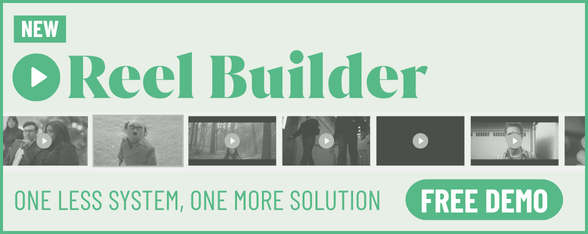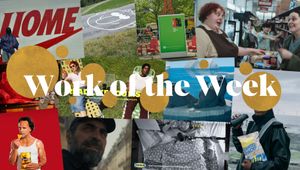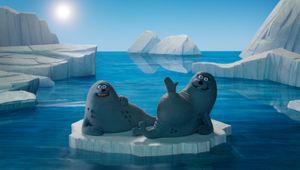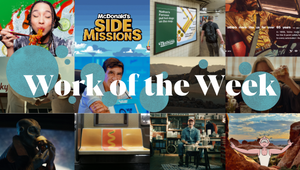
Whitney James' Editing Heroes

Whitney James is a video editor at Where The Buffalo Roam. She first started editing in middle school, making skate videos for her friends. From there, she fell in love with the craft, its rhythm, and the countless ways to tell stories through it.
LBB> The first cut is the deepest: how do you like to start an editing project?
Whitney> When starting a new project, I like to look at the footage that’s caught between takes. It’s in those moments that I find some of the most interesting camera movements and off-script natural reactions and emotions from the actors.
LBB> Non-editors often think of editing just in technical terms, but it’s integral to the emotion and mood of a film. How did you develop that side of your craft?
Whitney> I began my editing career working in documentary television alongside story producers and learned from senior editors how to build out a good story. My time editing long-form content gave me an appreciation for storytelling, all that goes into telling a good one, the skills necessary, and the importance of understanding emotion and mood and how they need to come across.
LBB> How important is an understanding of the story and the mechanics of the story?
Whitney> Story is the backbone of every good edit. Without it, the audience becomes lost and disengaged. Understanding the right hooks and moments to pull emotion out of the audience is especially important. Whether it’s a 30-second commercial that sets up a joke and the payoff/landing of that joke or a three-minute video with a more intricate arch and character development, the story is always at the foundation. It’s the scaffolding on which all other creative decisions are built on.
LBB> Rhythm and a sense of musicality seem to be intrinsic to good editing (even when it’s a film without actual music) – how do you think about the rhythm side of editing, how do you feel out the beats of a scene or a spot? And do you like to cut to music?
Whitney> Finding the rhythm of an edit is one of my favourite parts of the job.
I grew up editing skate videos for my brother and his friends, and in that process, I learned the importance of rhythm.
Whether I’m cutting to music or the natural rhythm of the actions taking place, it’s in putting the information together that I find the natural cadence of a piece. While I love to cut to music, I find the most enjoyment out of cutting to the natural rhythm of what’s visually going on.
In light of this, building out rhythm via sound design is probably where I thrive most. Considering how important it is to get to know the visual beats of an edit, I will always go back and watch my cuts with the audio turned off and tweak specific transitions that way as well.
LBB> Tell us about a recent editing project that involved some interesting creative challenges.
Whitney> I recently worked on a piece for LinkedIn that required creating a song using the natural sounds of a busy office. It was a great exercise in editing with rhythm. However, what became challenging was finding enough footage to match the rhythm and timing of each sound effect since each sound had to mirror the action on the screen.
LBB> In the US, we know that editors are much more heavily involved across the post-production process than in Europe – what’s your favourite part of that side of the job?
Whitney> I’ve always loved the process of sound design, and I find creating my own rough sound design for reviews extremely enjoyable. Getting footage back from colour is also a highlight. Colourists are true wizards, and it’s extremely rewarding to see your edit come to life during conform.
LBB> What’s harder to cut around – too much material or not enough? (And why?)
Whitney> For me, too much material is always harder to cut around. I find that too many options can actually limit my creativity. Problem-solving is where an editor thrives, and perhaps especially so when editing with less than an ideal amount of footage.
LBB> Which commercial projects are you proudest of and why?
Whitney> The pieces I did for Nike’s ‘Hands On’ series and Pitchfork/White Claw.
I had the privilege of working with the director, Ariel Fisher, on both projects. The cuts involved experimenting with collages and sound design. It was a joy to mix mediums in ways I hadn’t tried before, and it stretched me creatively, for which I’m very thankful.
LBB> There are so many different platforms for film content now, and even in advertising something can last anything from a few seconds to a couple of hours. As an editor, are you seeing a change in the kind of projects you’re getting from brands and agencies?
Whitney> I’m seeing a lot of brands becoming more comfortable and knowledgeable about the platforms they are advertising on. Because of this, we’re doing more catered content. This means we may do a couple of versions of the same cut. One that may feel more native to TikTok and another that fits well in an Instagram reel.
We’re not making one video that is the same across all platforms anymore but rather multiple versions of that video, each slightly different, to make it feel intuitive and natural to the platform it’s posted on.
LBB> Who are your editing heroes and why? What films or spots epitomise good editing for you?
Whitney> Sally Menke, Walter Murch, and Joe Walker immediately come to mind.
Growing up, I was deeply inspired by Sally Menke and her influence on film; her team-up with Tarantino was a great example of a thriving editor/director relationship.
Walter Murch has some of the best insights into our craft that one could ask for. His book, 'Blink of an Eye’, is a must-read for any editor.
Joe Walker is an editor who has inspired me these last few years. He’s able to edit sequences that are profoundly difficult with such a light touch that it makes them look easy. I also find the pacing of his work beautiful. The opening sequence and credits of Ingmar Bergman’s 'Persona' epitomise good editing.
They’re a masterclass in rhythm, experimentation, and sound design. I often rewatch them for inspiration.
LBB> How does editing in the commercial world differ from the film world and TV world?
Whitney> The biggest difference between the two is the amount of time given to tell a story and build emotion. In commercial editing, you have, at max, a couple of minutes, while in a film, you have hours. In commercial editing, you need to find a way to create an emotional connection between the content and the audience without the help of a lot of character development. This is why music has become such a helpful tool in short-form editing.
LBB> Have you noticed any trends or changes in commercial editing over recent years
Whitney> We live in a post-social media world where content on YouTube and TikTok is consumed rapidly. Edits have become much faster-paced, and hard transitions are becoming more fashionable.
For example, you will see a lot of YouTube content edited with jump cuts that are so abrupt the audio is even cut midway through. It’s not because of sloppy editing that this is happening –it’s a creative choice on the editor’s part, which I find fascinating. It’s as if the textbook editing rules are getting thrown out the window.















